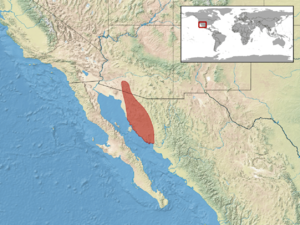Sonoran shovelnose snake facts for kids
Quick facts for kids Sonoran shovelnose snake |
|
|---|---|
| Conservation status | |
| Scientific classification | |
| Genus: |
Sonora
|
| Species: |
palarostris
|
 |
|
| Synonyms | |
|
|
The Sonoran shovelnose snake (Sonora palarostris) is a small snake that lives in the Sonoran Desert in North America. It is a type of colubrid snake, which means it is not venomous. This snake is known for its unique look and how it lives in the desert.
Contents
What Does Its Name Mean?
The scientific name for this snake is Sonora palarostris. The second part of its name, palarostris, comes from two Latin words. Pāla means "shovel," and rōstrum means "beak" or "snout." This name perfectly describes the snake's nose, which is shaped like a shovel. This special snout helps it dig in the sand.
Where Does It Live?
The Sonoran shovelnose snake lives in the southwestern United States and northwestern Mexico. In the U.S., you can find it only in a special place called Organ Pipe Cactus National Monument in Arizona. The type of shovelnose snake found there is called the Organ Pipe shovelnose snake. In Mexico, it lives only in the state of Sonora.
What Does It Look Like?
This snake has cool patterns! It has bands of black, yellow (or whitish), and red colors. Because of these colors, it can sometimes look like the Sonoran coral snake. However, there's an easy way to tell them apart. The Sonoran shovelnose snake has a yellow snout, while the coral snake has a black snout. Also, the Sonoran shovelnose snake is not venomous, but the coral snake is.
Another big difference is on their bellies. The coral snake's colorful bands go all the way around its body. But the Sonoran shovelnose snake has a solid yellow belly. This is a good way to tell them apart safely.
Adult Sonoran shovelnose snakes can grow up to about 43 centimeters (17 inches) long, including their tail.
Different Kinds of Shovelnose Snakes
Scientists recognize two main types, or subspecies, of the Sonoran shovelnose snake:
- Sonora palarostris organica - This is known as the Organ Pipe shovelnose snake.
- Sonora palarostris palarostris - This is the Sonoran shovelnose snake, which is the main type.
How Does It Behave?
The Sonoran shovelnose snake is mostly active in the evening and at night. It likes to move around when the desert heat cools down. You can often find it near dry riverbeds or washes, which are areas where water flows during rains. Its shovel-like snout is perfect for digging and moving through the sandy soil in these areas.


